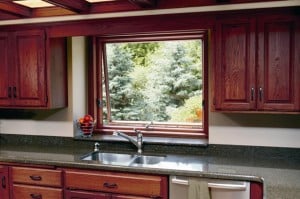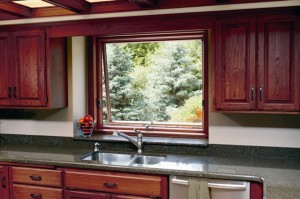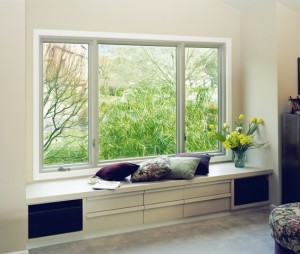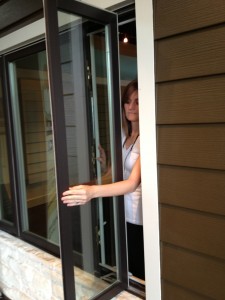Energy Efficient Window Replacement: Awning Windows vs Casement Windows
June 4th, 2013 | 5 min. read
By Jenica Lee
Get weekly updates with the most recent articles and videos from Southwest Exteriors.
Subscribe
When considering energy efficient window replacement for their home, a lot of folks have questions about which styles of windows they should choose. To help everyone be well informed in the decision making process, we’re doing an article series on a comparison of different window styles. In our last article of comparing different window styles, we talked about double hung windows and gliding windows. Today’s article will focus on the benefits and disadvantages the two styles that crank open and closed on hinges: Awning Windows vs Casement Windows.
Awning Windows: Pros and Cons
 Awning windows tilt open at the bottom with a hinge at the top. The great thing about these windows is that they can be used in an area where you want to preserve the view that you have outside but still have the functionality of bringing air whenever you want to, even when it is raining. Awning windows are usually a great solution for the window over the kitchen sink because the opening mechanism is a simple crank that’s easily within reach (otherwise, you would have to climb up on top of your sink or some other ledge to open that window).
Awning windows tilt open at the bottom with a hinge at the top. The great thing about these windows is that they can be used in an area where you want to preserve the view that you have outside but still have the functionality of bringing air whenever you want to, even when it is raining. Awning windows are usually a great solution for the window over the kitchen sink because the opening mechanism is a simple crank that’s easily within reach (otherwise, you would have to climb up on top of your sink or some other ledge to open that window).
Awning windows provide fantastic ventilation, ease of operation, and a great view outside, since there are no bars or check rails in the middle like double hung and gliding windows have. They are best suited for smaller window openings, like the one over the kitchen sink, that are wider than they are tall. A downside to awning windows is the space outside the window that’s needed to allow it to open outward. Tall shrubbery or tree branches right outside the window would prevent or at least hamper the awning window from being opened, so landscaping is an important factor to consider. The outside of awning windows also cannot be cleaned from inside, so keeping them on the first story of your house is recommended.
Casement Windows: Pros and Cons and Energy Efficient Window Replacement
 Casement windows are another very popular window selection, and they're actually my personal favorite type of window. These windows also opened using a cranking mechanism like awning windows, but are hinged on the side instead of the top. An added bonus: if you're looking for energy efficient window replacement, casement windows are your best option.
Casement windows are another very popular window selection, and they're actually my personal favorite type of window. These windows also opened using a cranking mechanism like awning windows, but are hinged on the side instead of the top. An added bonus: if you're looking for energy efficient window replacement, casement windows are your best option.
There are several factors that make casement windows my personal favorite.
- Unobstructed View. Casement windows provide an unobstructed view of outside while still allowing for ventilation and egress (exiting the house). We see a lot of folks in the Texas Hill Country that want to preserve the beautiful views that they have outside of their home, and casement windows have the exact look of a fixed or picture window but still follow egress codes and can let a nice breeze in.
- Tight Seal. Another benefit to casement windows is that they have the tightest seal and thus become the highest performing operable window that you could put in your house in terms of energy efficiency. Casement windows seal like your refrigerator door with weather stripping and sealing systems around all four sides of the window. The weather stripping is compression-fit, so when the window is fully closed and locked, a very tight seal is created unlike any other operable window that you could put in your house. These are the best types of windows for energy efficient window replacement.
- Great Ventilation. The third thing I like about casement windows is their ventilation capability. Just as a sail on the sailboat is meant to catch as much air and breeze as possible, the casement window provides the same exact effect of catching air outside the home and redirecting it inside alongside the full-length panel. When a casement window is opened only four to five inches, it can bring in much more air than a fully open double hung or gliding window.
- Easy Cleaning. Finally, they are still easy to clean from inside the house because they can rotate fully so both sides of the glass are easily accessed. Casement windows, like awning windows, will also help keep your screens and the space between your window and screen clean because the screens are on the interior of the house.
 Casement windows usually work best on smaller windows that are taller than they are wide (opposite of awning windows). A downside to casement windows is the space needed outside for them to open fully—if there are trees or shrubbery right outside the window, they will block the window from being able to open. Another downside is that large casement windows in a windy area tend to catch so much wind that the hinges can end up twisting out of shape a little, which makes the window difficult to crank open and closed. The weight of the glass on very large casement windows can also be heavy enough to bend the hinges out of shape, as well. This is why small to medium-size openings are generally a much better fit for this type of window.
Casement windows usually work best on smaller windows that are taller than they are wide (opposite of awning windows). A downside to casement windows is the space needed outside for them to open fully—if there are trees or shrubbery right outside the window, they will block the window from being able to open. Another downside is that large casement windows in a windy area tend to catch so much wind that the hinges can end up twisting out of shape a little, which makes the window difficult to crank open and closed. The weight of the glass on very large casement windows can also be heavy enough to bend the hinges out of shape, as well. This is why small to medium-size openings are generally a much better fit for this type of window.
In our next article, we’ll talk about the different types of fixed windows: picture windows, specialty windows, and transom windows. You can also read our previous article on Double Hung and Gliding windows here. If you have any other questions, don’t hesitate to contact us directly.
